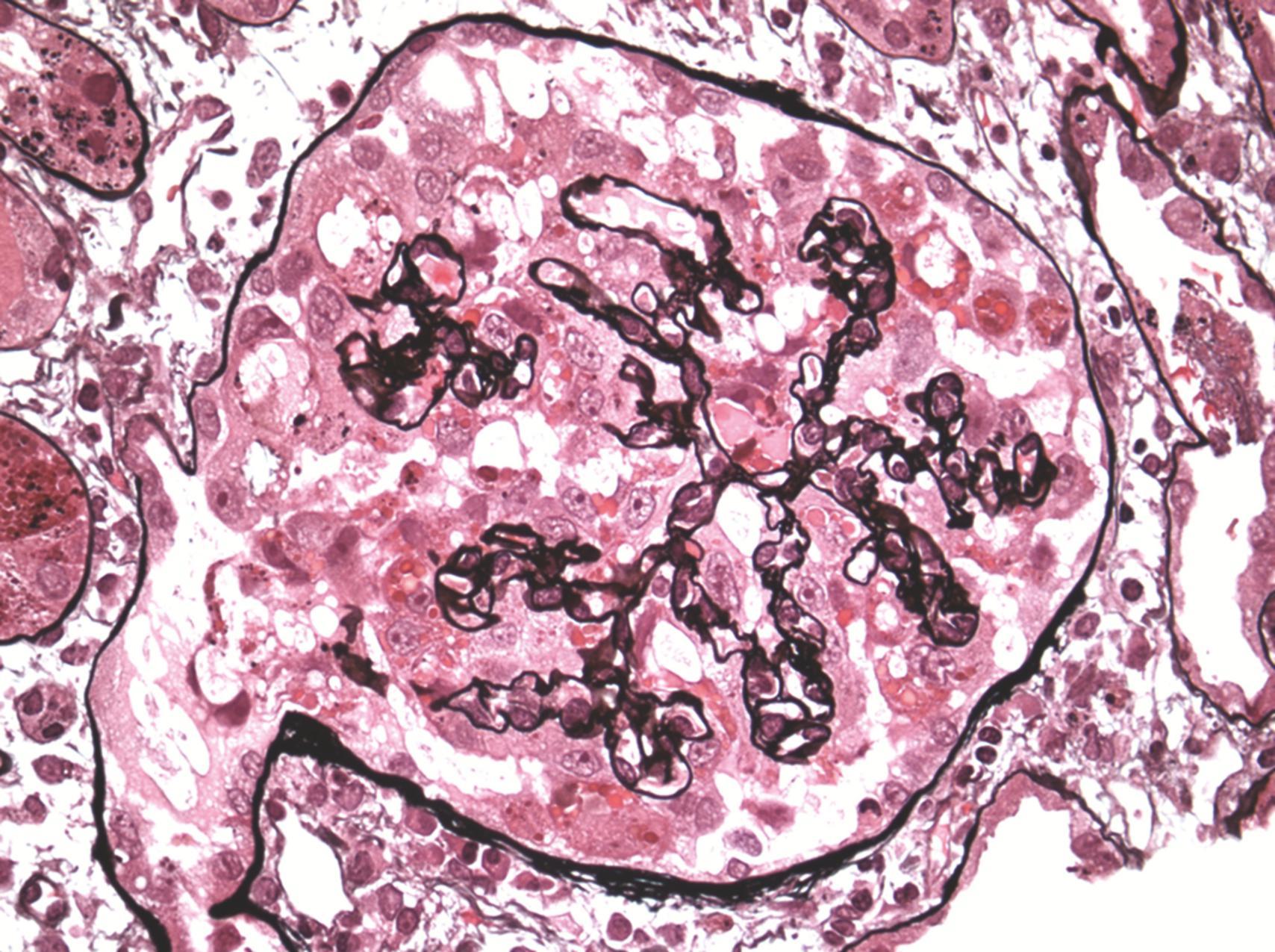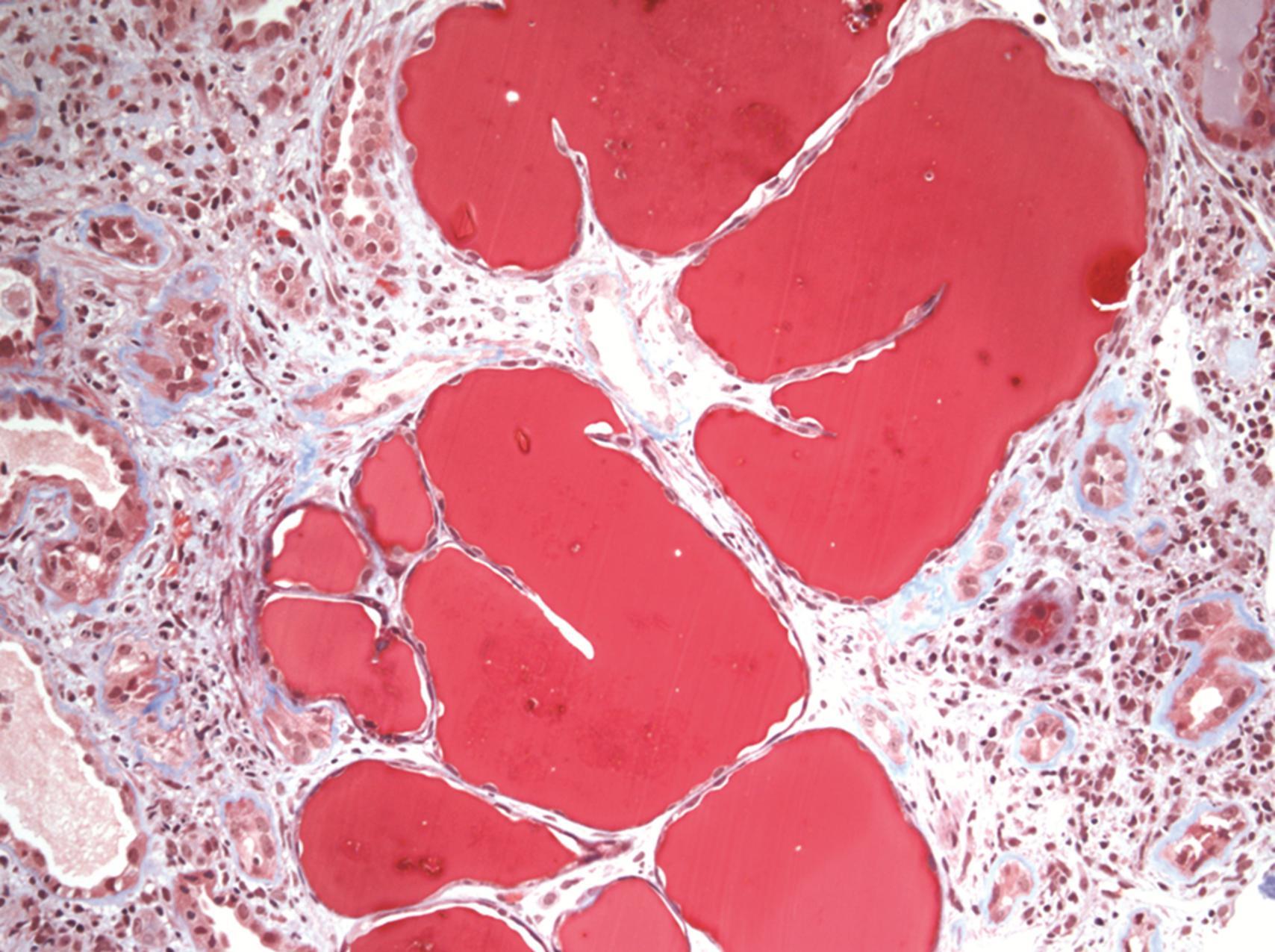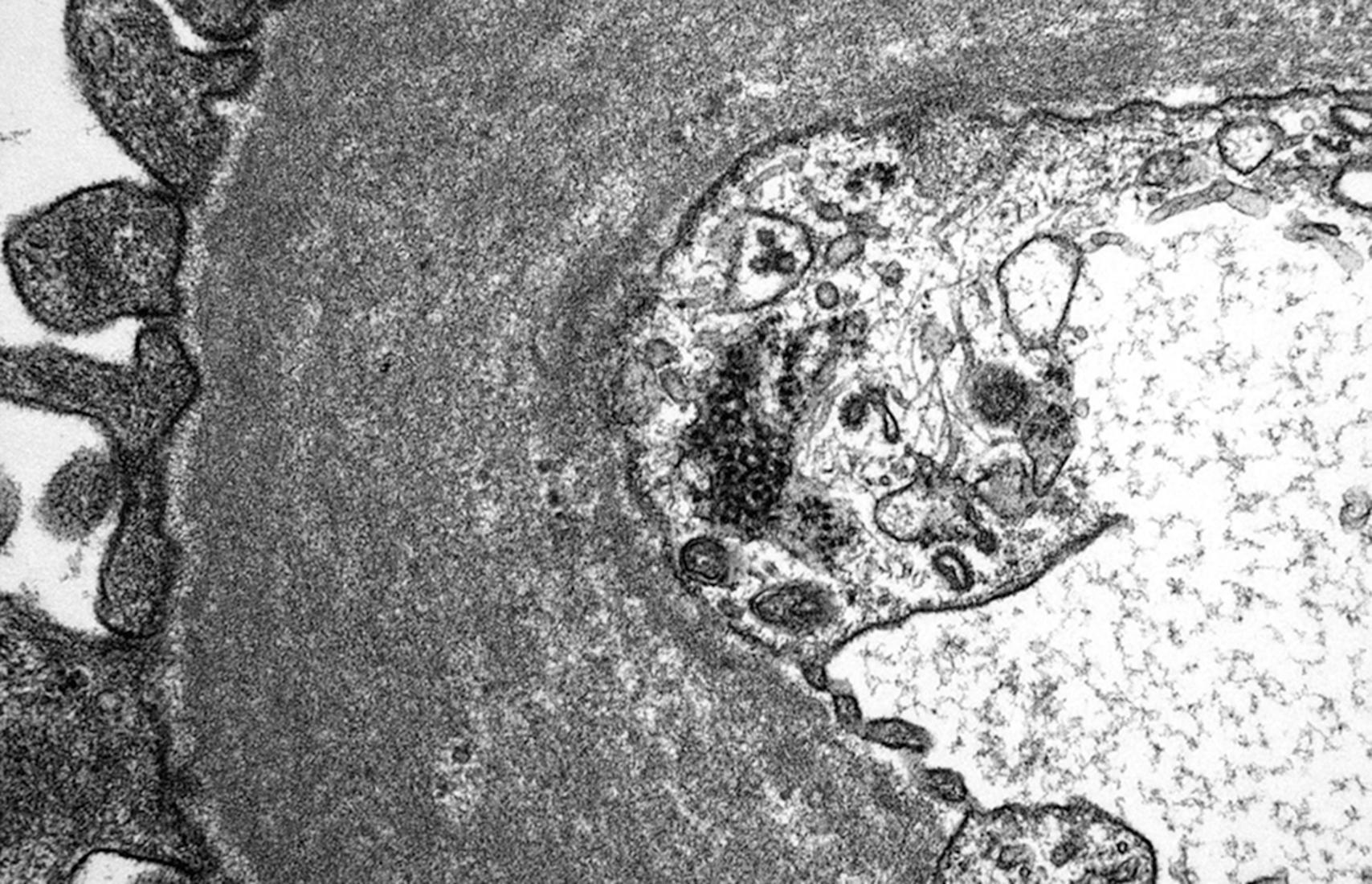Physical Address
304 North Cardinal St.
Dorchester Center, MA 02124
Human immunodeficiency virus (HIV), hepatitis C virus (HCV), and hepatitis B virus (HBV) are the most important causes of viral-related kidney disease in the world. Several mechanisms are involved in the pathogenesis of virus-related kidney disease, including tropism of the virus in the kidney, direct cytopathic effects, and immune response to the virus including production of immune complexes. These lead to a spectrum of glomerular and tubulointerstitial diseases. Some of the most important features of the kidney diseases associated with these viruses are shown in Table 24.1 .
| HIV | HCV | HBV | |
| Major risk groups | Infected individuals of African ancestry who are homozygous for APOL1 gene polymorphisms | Adults with longstanding untreated chronic HCV infection | Children and adults from HBV endemic areas |
| Presentation | Proteinuria, nephrotic syndrome, with rapid eGFR declineLarge, echogenic kidneys on ultrasoundAdvanced HIV (if HIVAN) | HematuriaProteinuriaHypocomplementemiaPalpable purpuraSystemic vasculitisCryoglobulinemia | ProteinuriaNephrotic syndrome |
| Primary kidney pathology | Collapsing FSGSMicrocystic dilation of tubulesInterstitial inflammation/fibrosis | MPGN | MN |
| Pathogenesis | Direct HIV infectionHost genetic factorsImmune complex deposition | Direct HCV toxicityCryoglobulinemiaImmune-complex deposition | Antigen-antibody complex deposition causing membranous nephropathy or vasculitis |
| Therapy | ARTACE-I and ARBs | Direct-acting antiviral therapySteroids and RituximabCyclophosphamide +/- Plasmapheresis in severe cases | Antiviral therapy |
Kidney disease is a frequent complication of HIV infection. The classic kidney disease caused by HIV is a form of collapsing focal segmental glomerulosclerosis (FSGS), referred to as HIV-associated nephropathy (HIVAN). Its pathophysiology is linked to viral gene replication within kidney cells. Immune complex-mediated glomerular diseases have been associated with HIV infection; however, the mechanistic link to HIV is undefined. Finally, the use of antiretroviral therapies (ARTs) has led to long-term survivorship and, thus, an increasing prevalence of diabetic nephropathy, hypertensive nephrosclerosis, and arteriopathy in patients with HIV, as well as chronic kidney disease (CKD) that result from chronic ART use.
In the setting of HIV infection, kidney disease is mediated by factors related to the virus, host genetic predisposition, host response to infection, and environmental factors. HIVAN typically occurs in patients of African ancestry. This predilection is associated with high frequencies of APOL1 genetic polymorphisms on chromosome 22 in this population, specifically G1 (two missense mutations) and G2 (two base pair deletion). The G1 and G2 variants confer risk for HIVAN and an HIV-associated noncollapsing form of FSGS, as well as other glomerular diseases and arteriolar nephrosclerosis. The effect is largely recessive, in that homozygous (G1/G1 or G2/G2) or compound heterozygous (G1/G2) individuals have the highest risk of HIVAN. The mechanisms by which the risk variant proteins alter kidney cell function and lead to CKD and end-stage kidney disease (ESKD) remain unclear and are a matter of considerable interest and ongoing research.
Evidence from clinical and animal studies supports a direct role of HIV infection of renal parenchymal cells in the pathogenesis of HIVAN. Although renal epithelial cells do not generally express viral receptors, uptake of HIV into renal epithelial cells is thought to be mediated by transfer from infected lymphocytes. Expression of HIV transgenes in podocytes and renal tubular epithelial cells results in de-differentiation and/or loss of expression of important proteins (e.g., nephrin), which leads to apoptosis, proliferation, and tubular microcyst formation. Expression of HIV regulatory and accessory proteins in HIV transgenic mice (Tg26 or TgFVB) produces the glomerular and tubular features of HIVAN-like pathology, even in the absence of intact virus, thereby supporting the direct effects of HIV transcript expression in glomerular (mesangial and epithelial) and tubular cells. The mechanism that drives aberrant expansion of podocyte stem cells, which are located in the parietal epithelium, remains unknown.
The classic presentation of HIVAN is nephrotic syndrome, with rapid estimated glomerular filtration (eGFR) loss, relatively bland urinary sediment, and large, often densely echogenic kidneys on ultrasound. Most patients are normotensive and relatively edema free despite advanced CKD, possibly due to salt wasting from the prominent tubular abnormalities in HIVAN. HIVAN occurs predominantly in those of African ancestry with advanced HIV (high viral loads, CD4 counts less than 200 cells/µL), but HIVAN may also occur at the time of acute HIV seroconversion when viral load is often very high. Left untreated, HIVAN progresses rapidly to ESKD, often in a few months.
The characteristic pathologic changes of HIVAN are observed along the full length of the nephron with glomerular and tubulointerstitial features. Light microscopy reveals a collapse of glomerular capillaries that typically involves the entire glomerulus ( Fig. 24.1 ), visceral glomerular epitheliosis, podocyte hypertrophy and proliferation surrounding the shrunken glomerulus, and mesangial prominence and hypercellularity. Tubular injury is marked by microcystic tubular dilation, tubular atrophy, and proteinaceous casts ( Fig. 24.2 ). Many patients have modest interstitial inflammation with lymphocytes, plasma cells, and monocytes. Immunofluorescence is generally nonspecific, and electron microscopy shows diffuse food process effacement with frequent endothelial tubuloreticular inclusions (TRIs) but no immune complex deposits ( Fig. 24.3 ).



ART is key to preventing and treating HIVAN. Previously, kidney disease was an important indication for early initiation of ART; however, current guidelines recommend initiating ART in all patients with HIV as soon as possible, regardless of CD4 count. The use of ART has been associated with a lower incidence of HIVAN, improved kidney function, and lower risk of ESKD. Control of blood pressure and proteinuria with angiotensin-converting enzyme (ACE) inhibitors and angiotensin receptor blockade (ARB) are important to slow progression of HIVAN. Immunosuppression is not recommended in patients with HIVAN; corticosteroids have not shown sufficient efficacy, and the risk of infectious complications is high.
Patients with HIVAN may progress to ESKD despite ART. Mortality rates of HIV-infected dialysis patients are slightly higher than HIV-uninfected dialysis patients, particularly among non-Caucasian patients. The outcome of kidney transplantation in HIV-positive patients who receive organs from HIV-negative or HIV-positive donors is similar to the outcome of HIV-negative recipients and HIV-negative donors. There is a clear survival advantage for HIV-infected patients who undergo kidney transplantation compared to remaining on dialysis. Classic HIVAN does not seem to recur in allografts, but other immune complex-related kidney diseases may. There are important interactions between antiretroviral drugs and posttransplant immunosuppressants. Ritonavir, an inhibitor of cytochrome P450 enzyme systems, decreases metabolism of tacrolimus, resulting in up to a fivefold increase in blood levels. In contrast, the NNRTIs efavirenz and nevirapine induce P450s and increase metabolism of tacrolimus, necessitating much higher doses to maintain adequate levels.
Immune complex-mediated glomerular diseases that have been associated with HIV infection include cryoglobulinemic glomerulonephritis (particularly in patients co-infected with HCV), IgA nephropathy, membranous glomerulopathy, and “lupus-like” glomerulonephritis (a proliferative glomerulonephritis with a “full-house” immunofluorescence, but without serologic or clinical evidence of systemic lupus erythematosus). These diseases are heterogenous, and the association with HIV is not well understood. Chronic HIV infection is associated with polyclonal expansion of immunoglobulins, and immune complex disease may result from deposition from the systemic circulation or from in situ binding of immunoglobulins to lodged HIV antigens; however, there is very limited understanding of the epidemiology and pathophysiology of immune complex-mediated glomerular disease in patients with HIV. Previous studies have shown there is no strong association with race or APOL1 genotype. A recently published KDIGO consensus guideline recommended that the terminology HIV-associated immune complex kidney disease (“HIVICK”) be replaced with the specific description of the immune complex disease followed by “in the setting of HIV.” There are three important reasons for this distinction: First, there is no clear mechanistic link between HIV and these glomerular lesions; second, patients should undergo a work-up searching for other potential causes for these kidney diseases; and, finally, ART therapy alone is unlikely to improve kidney function. Patients with well-controlled HIV infection should be strongly considered for immunosuppressive therapies using standard-of-care approaches to treat the underlying immune complex-mediated glomerular disease.
Finally, HIV-related thrombotic microangiopathy presents similarly to idiopathic forms of TMA with hypertension, acute kidney injury (AKI), microscopic hematuria, and non-nephrotic proteinuria, along with features of a microangiopathic hemolytic anemia. It is an uncommon presentation that typically occurs in patients with very advanced AIDS.
ART nephrotoxicity is an important cause of AKI and CKD in patients with HIV ( Table 24.2 ). Common, currently used ARV such as tenofovir disoproxil fumarate, a nucleoside reverse transcriptase inhibitor (NRTI), may cause proximal tubular damage and Fanconi syndrome due to uptake of its active metabolite, tenofovir, into the proximal tubular cell where it can inhibit mitochondrial DNA synthesis. Tenofovir-induced nephrotoxicity causes proximal tubulopathy, which can result in hypophosphatemia, nonalbumin proteinuria, and, in its severe form, Fanconi syndrome or acute tubular necrosis (ATN). Dose adjustment of tenofovir according to eGFR is mandatory to minimize nephrotoxic effects. Tenofovir alafenamide is a newly approved NRTI pro-drug that may be less nephrotoxic.
| Class | Renal Abnormality |
| Nucleos(t)ide Reverse Transcriptase Inhibitors | |
| Abacavir | Lactic acidosis, AIN a , Fanconi syndrome a |
| Didanosine | Lactic acidosis, AKI, proximal tubule dysfunction, Fanconi syndrome, nephrogenic diabetes insipidus |
| Lamivudine | Lactic acidosis, renal tubular acidosis, hypophosphatemia a |
| Stavudine | Lactic acidosis, renal tubular acidosis, hypophosphatemia a |
| Zidovudine | Lactic acidosis |
| Tenofovir | Proximal tubule dysfunction with Fanconi syndrome, nephrogenic diabetes insipidus, nonalbumin proteinuria, CKD, acute and chronic tubular injury, severe ATN |
| Adefovir | Proximal tubule dysfunction with Fanconi syndrome, AKI, nephrogenic diabetes insipidus, lactic acidosis |
| Non-Nucleoside Reverse Transcriptase Inhibitors | |
| Efavirenz | Nephrolithiasis |
| Protease Inhibitors | |
| Atazanavir | Nephrolithiasis, crystalline nephropathy, AIN a |
| Indinavir | Crystalluria, nephrolithiasis, interstitial nephritis (AKI, CKD), papillary necrosis, hypertension, renal atrophy |
| Nelfinavir | Nephrolithiasis a |
| Ritonavir | AKI, hyperuricemia |
| Saquinavir | AKI in association with ritonavir |
| Darunavir | Crystalluria, nephrolithiasis, crystalline nephropathy |
| Fusion or Entry Inhibitors | |
| Enfuvirtide | Membranoproliferative glomerulonephritis a |
| Integrase inhibitors | |
| Dolutegravir | Inhibition of creatinine secretion |
| Other Antimicrobials | |
| Acyclovir | AKI, crystalluria, obstructive nephropathy |
| Aminoglycosides | AKI, renal tubular acidosis |
| Amphotericin | AKI, hypokalemia, hypomagnesemia, renal tubular acidosis |
| Cidofovir | Proximal tubular damage, bicarbonate wasting, proteinuria, AKI |
| Foscarnet | AKI, hypocalcemia and hypercalcemia, hypophosphatemia and hyperphosphatemia, hypomagnesemia, nephrogenic diabetes insipidus |
| Pentamidine | AKI, hyperkalemia, hypocalcemia |
| Rifampin | Interstitial nephritis |
| Sulfadiazine | Proximal tubule dysfunction |
| Valacyclovir | Thrombotic microangiopathy |
a Case reports. AIN, Acute interstitial nephritis; AKI, acute kidney injury; CKD, chronic kidney disease; ATN ; acute tubular necrosis
Atazanavir is a protease inhibitor that can lead to AKI from intratubular crystal formation or nephrolithiasis. Atazanavir stones can be hard to diagnose even on computed tomography because they are radiolucent. Kidney stones occur in 1%-2% of atazanavir users, substantially lower than was seen with indinavir, a protease inhibitor no longer in use that was notorious for causing kidney stones. Darunavir, another protease inhibitor is also rarely associated with crystalluria, nephrolithiasis, and crystalline nephropathy.
Both dolutegravir, an integrase inhibitor, and cobicistat, a CYP inhibitor used to boost levels of certain protease inhibitors, may cause a slight rise in creatinine (0.2–0.3 mg/dL) due to inhibition of creatinine secretion, but neither is nephrotoxic. Cystatin c-based eGFR equations accurately reflect kidney function in patients on these agents. Patients with HIV may be commonly treated with other medications that can also cause nephrotoxicity (see Table 24.2 ). Additional material on kidney disease caused by therapeutic agents can be found in Chapter 34.
Increasing comorbidity burden among the aging HIV-infected population leads to high rates of CKD. The incidence of HIVAN has decreased due to the widespread use of ART, and the distribution of HIV-associated kidney disease has changed substantially over the last 30 years. Whereas in 1989 HIVAN was the most common lesion found on kidney biopsy, a recent biopsy series out of New York City shows that immune complex disease, diabetic nephropathy, HIVAN, tenofovir toxicity, and non-HIVAN FSGS each make up 12%-16% of kidney biopsy diagnoses. Though ART led to a decline in the incidence of HIVAN, with a corresponding reduction in ESKD attributed to HIVAN, the rates of ESKD are still higher in the HIV-infected population.
Prolonged use of ART and the corresponding increased life span of HIV-infected individuals have led to increasing comorbidity burden and higher prevalence of associated kidney disease in patients with HIV. Despite the suppression of HIV replication with ART, a state of chronic inflammation and dysmetabolism persists, which is linked to diabetic kidney disease, arteriolar nephrosclerosis, and possibly FSGS.
Become a Clinical Tree membership for Full access and enjoy Unlimited articles
If you are a member. Log in here